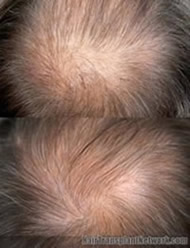
Today's ultra-refined follicular unit hair transplantation has the potential to deliver natural and undetectable results. However, as with any surgical procedure, it's not without its limitations. Two of the most significant of these are scarring and limited donor supply. But, what if these concerns could be virtually eliminated through the use of a naturally-occurring material known as ACell MatriStem?

What is ACell MatriStem?
ACell MatriStem is an FDA approved extracellular matrix (ECM) derived from pig urinary bladder (UBM). ECM is the non-cellular component present within the tissues and organs of all animal species. Because the makeup of ECM is identical in all species, animal ECM can be used in humans with no fear of adverse reaction.
ACell MatriStem Contains:
- Structural proteins
- Collagen types: I, II, III, IV, V, VI, VII
- Proteoglycans
- Growth Factors
- VEGF, BMP4, PDGF-BB, KGF, TGFbeta1, IGF, bFGF, EGF, TGFalpha
- Glycoproteins
- Laminin, Elastin, Fibronectin
- Anti-Infective Peptides
- 18 AMPs have been identified in porcine tissue
- Porcine defensin pBD-1
The Uses of ACell MatriStem
ACell has a wide range of applications in general and plastic surgery, wound care, burn treatment and even gynecology. The use of ECM in surgery has been found to enhance wound healing, promote tissue regeneration, and inhibit scarring. These attributes also offer potential benefits to hair loss sufferers seeking to surgically restore thinning hair.
Coalition member Dr. Jerry Cooley of Charlotte, NC has been researching the effects of ACell on four areas of hair restoration surgery; punch harvest sites (small follicular unit excision (formerly know as follicular unit extraction) or FUE and larger), strip harvest donor healing, FU (follicular unit) grafting, and Hair Duplication (Autocloning) with plucked hair.
How ACell Works
ACells pig urinary bladder (UBM) appears to fundamentally change the healing response by providing signals to the immune system that stimulate an adaptive or accommodative response, conducive for wound healing and three-dimensional growth of various cell types.
UBM has been shown to:
- Recruit progenitor cells (a biological cell that, like a stem cell, has a tendency to differentiate into a specific type of cell, but is already more specific than a stem cell)
- Demonstrate chemotactic and mitogenic activities. Chemotactic activity refers to a cells tendency to migrate toward or away from certain chemical stimuli. Mitogenic activity refers to the process of mitosis or transformation of cells when chromosomes in the cells nucleus split into two identical sets of chromosomes, each set in its own new nucleus.
- Constructively remodel site-specific tissues where scarring would be expected. In other words, UBM may enhance healing by reducing the skins tendency to produce scar tissue in a healing wound. The resulting tissue is more supple and normal in appearance.
Hair Duplication (formerly Autocloning)
 Hair Duplication with ACell works on the principle that a hair, when plucked properly, will emerge with its epithelial cells (cells from which the hair and nails are formed) and follicular stem cells intact. According to Dr. Jerry Cooley, applying ACell to the plucked hair and then implanting it into the scalp stimulates the bodys innate regenerative potential in order to rebuild a completely new follicle including sebaceous gland and dermal papilla. Sebaceous glands are microscopic glands in the skin that secrete sebum to lubricate and waterproof the skin and hair. The dermal papilla (DP) regulates hair follicle development and growth and is also thought to be a reservoir of multi-potent stem cells.
Hair Duplication with ACell works on the principle that a hair, when plucked properly, will emerge with its epithelial cells (cells from which the hair and nails are formed) and follicular stem cells intact. According to Dr. Jerry Cooley, applying ACell to the plucked hair and then implanting it into the scalp stimulates the bodys innate regenerative potential in order to rebuild a completely new follicle including sebaceous gland and dermal papilla. Sebaceous glands are microscopic glands in the skin that secrete sebum to lubricate and waterproof the skin and hair. The dermal papilla (DP) regulates hair follicle development and growth and is also thought to be a reservoir of multi-potent stem cells.
Since plucked hairs also regrow in the original site, a potentially limitless donor supply is created, providing hair loss sufferers with the possibility of restoring a full head of hair. While very exciting news, it is important to note that there is still much research yet to be conducted.
For a more comprehensive discussion on hair duplication and ACell including Dr. Jerry Cooley's findings and results, visit "Dr. Jerry Cooleys Presentation on ACell MatriStem in Hair Restoration and Hair Duplication (Formerly Known As Autocloning)".
Potential Benefits of ACell in Hair Transplant Surgery
- Donor Harvest Sites - Dr. Cooley found that using ACell in FUE hair transplant punch harvest sites resulted in virtually undetectable scarring. However, follicular unit strip surgery (FUSS), ACell improved the feel more than the appearance of scarring.
- Recipient Sites - When applied to the grafts prior to implantation, ACell resulted in better than expected robust growth.
- Hair Duplication Under optimal conditions, ACell can facilitate follicle regeneration from implanted plucked hairs. When these plucked hairs are implanted, they sometimes grow - resulting in two hairs from a single follicle.
Conclusion
ACell is being increasingly offered by a number of world-class hair transplant clinics around the globe. However, its full potential is still being studied. While these results are exciting, more research is required to fully understand the role this technology will ultimately play in hair restoration surgery.

















